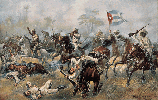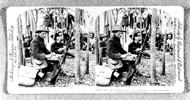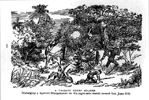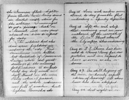
PART III: POPULAR PARTICIPATION, 1898-1899
15. PORTRAYALS OF CUBAN AND U.S. FORCES
 Popular
participation during the Spanish-American War took different forms, both on
the home front and on the battlefront. The considerable efforts of the war,
involving naval campaigns in two oceans and the landing of troops overseas,
entailed participation by members of various social and ethnic groups, of both
sexes and a range of ages. Of the approximately 20,000 U.S. troops that participated
actively in the Cuban campaign, the majority were regular soldiers (of whom
7,000 were African Americans) and only 7,400 were volunteers. Most of the 200,000
volunteers recruited in the United States at the time of the war stayed at home
in military camps; only a third of them saw action in Cuba, the Philippines,
and Puerto Rico. The media portrayal of this participation emphasized
themes, scenes, and motives that aroused nationalistic, idealized feelings among
the
Popular
participation during the Spanish-American War took different forms, both on
the home front and on the battlefront. The considerable efforts of the war,
involving naval campaigns in two oceans and the landing of troops overseas,
entailed participation by members of various social and ethnic groups, of both
sexes and a range of ages. Of the approximately 20,000 U.S. troops that participated
actively in the Cuban campaign, the majority were regular soldiers (of whom
7,000 were African Americans) and only 7,400 were volunteers. Most of the 200,000
volunteers recruited in the United States at the time of the war stayed at home
in military camps; only a third of them saw action in Cuba, the Philippines,
and Puerto Rico. The media portrayal of this participation emphasized
themes, scenes, and motives that aroused nationalistic, idealized feelings among
the public even in isolated towns and rural areas. Photographs, stereoscopic views,
lantern slides, lithographs, drawings, and paintings expressed positive and
heroic images that did not necessarily reflect the realities of the war. Images
were also affected by changing perspectives, as in the case of the portrayal
of Cuban separatist fighters by media in the United States.
public even in isolated towns and rural areas. Photographs, stereoscopic views,
lantern slides, lithographs, drawings, and paintings expressed positive and
heroic images that did not necessarily reflect the realities of the war. Images
were also affected by changing perspectives, as in the case of the portrayal
of Cuban separatist fighters by media in the United States.
16. AFRICAN AMERICAN PARTICIPATION
 One
of the most significant yet little remembered chapters of popular participation
in the Spanish-American War concerns the role played by African Americans. Some
African Americans were eager to go to war in order to demonstrate their valor
and patriotism, and to improve the view of them held by whites. However, other
African Americans condemned what they saw as collaboration in establishing U.S.
overseas dominance over non-white populations, and feared that one result of
the conflict would be an increase in racial discrimination against blacks in
the United States. African Americans served in every major land and sea campaign.
There were black sailors on the Maine and the other major battleships
of the U.S. fleets. The regular troops of the 24th and 25th Infantry, and the
9th and 10th Cavalry ("Buffalo Soldiers"), under the command of white
officers, were at the forefront in the fight in Cuba and had distinguished war
records. In addition, several all-black voluntary regiments performed important
occupation tasks in Cuba, Puerto Rico, and the Philippines, where they developed
strong ties with the local populations.
One
of the most significant yet little remembered chapters of popular participation
in the Spanish-American War concerns the role played by African Americans. Some
African Americans were eager to go to war in order to demonstrate their valor
and patriotism, and to improve the view of them held by whites. However, other
African Americans condemned what they saw as collaboration in establishing U.S.
overseas dominance over non-white populations, and feared that one result of
the conflict would be an increase in racial discrimination against blacks in
the United States. African Americans served in every major land and sea campaign.
There were black sailors on the Maine and the other major battleships
of the U.S. fleets. The regular troops of the 24th and 25th Infantry, and the
9th and 10th Cavalry ("Buffalo Soldiers"), under the command of white
officers, were at the forefront in the fight in Cuba and had distinguished war
records. In addition, several all-black voluntary regiments performed important
occupation tasks in Cuba, Puerto Rico, and the Philippines, where they developed
strong ties with the local populations.
Exhibition Checklist
17. PERSONAL VIEWS
The war sent large numbers of men to foreign lands where they encountered circumstances worth relating in memoirs and personal reminiscences. Of approximately 200,000 volunteers, two-thirds did not see action overseas. The average volunteer was twenty-four years old, single, native born, and employed as a worker or farmer. Items in this section include two examples of individuals writing from personal perspectives, one, by a war correspondent, emphasizing personal courage and psychological strength among soldiers, and the other from the perspective of the common soldier.
18. SPANISH POPULAR PARTICIPATION
In Spain, the attitude of the people toward the war changed dramatically between March and August of 1898. Government and press campaigns had rallied enthusiastic support for the war, but after the naval defeats at Manila and Santiago, that support waned and a traumatic aftertaste developed. An undercurrent of resentment against military and political leaders developed among organized labor and in rural areas. These populations had been the most subject to forced conscription and suffered from food shortages that led to riots in May. Those who could pay were able to avoid military service. Moreover, the high death rate among Spanish soldiers in Cuba from war and disease, and the return of the wounded and maimed, and of former prisoners of war, aroused bitter sentiments that were increasingly expressed in the Spanish press and in cartoons. A sense of having been unfeelingly deceived and sacrificed by the authorities, despite, in some cases, heroic resistance, is apparent in the memoirs, accounts, and letters of ordinary soldiers. These experiences had a lasting effect on the psyche of the Spanish population.
19. RENEWED CONFLICT IN THE PHILIPPINES
The Treaty of Paris (December 10, 1898) formally ended the war between the
United States and Spain and arranged for the purchase of the Philippines by
the United States for $20 million. The Filipino leader Emilio Aguinaldo and
his nationalist movement expected that the United States would recognize their
self-proclaimed republican government. But President William McKinley decided
instead for a policy termed "benevolent assimilation." The status
of the Philippines was later formalized as an unincorporated territory under
U.S. rule.
 By
August 1898, approximately 10,000 U.S. troops had landed in the Philippines;
by 1900, there were 70,000. In February 1899, these troops faced a Filipino
contingent of 50,000 men at the start of the Philippine-American War. After
a first phase of conventional warfare on the island of Luzon (in the provinces
north of Manila), guerrilla warfare followed on Luzon and various other islands
in the archipelago. Pacification of the rural population was sometimes effected
through versions of forced relocation and other cruel actions. In March 1901,
Emilio Aguinaldo was captured by soldiers commanded by General Frederick Funston.
The U.S. troops in the Philippines included African Americans who were confronted
with racial dilemmas. Death and imprisonment of U.S. soldiers soon fueled complaints
and anti-imperialist demands in the United States.
By
August 1898, approximately 10,000 U.S. troops had landed in the Philippines;
by 1900, there were 70,000. In February 1899, these troops faced a Filipino
contingent of 50,000 men at the start of the Philippine-American War. After
a first phase of conventional warfare on the island of Luzon (in the provinces
north of Manila), guerrilla warfare followed on Luzon and various other islands
in the archipelago. Pacification of the rural population was sometimes effected
through versions of forced relocation and other cruel actions. In March 1901,
Emilio Aguinaldo was captured by soldiers commanded by General Frederick Funston.
The U.S. troops in the Philippines included African Americans who were confronted
with racial dilemmas. Death and imprisonment of U.S. soldiers soon fueled complaints
and anti-imperialist demands in the United States.
20. ORDINARY HEROES
 In a war that
offered few opportunities for heroic acts, some individuals were honored and
rewarded for their outstanding military service. Although the military honors
of African Americans were seldom reported in the major newspapers, some black
soldiers did receive official recognition and were a source of pride to their
families and communities. Some Cuban separatists who served in the war received
overdue official recognition but only promises to pay them for their war service.
However, most of the ordinary soldiers who lost their lives in defense of the
losing side received little recognition and were remembered only by their families.
In a war that
offered few opportunities for heroic acts, some individuals were honored and
rewarded for their outstanding military service. Although the military honors
of African Americans were seldom reported in the major newspapers, some black
soldiers did receive official recognition and were a source of pride to their
families and communities. Some Cuban separatists who served in the war received
overdue official recognition but only promises to pay them for their war service.
However, most of the ordinary soldiers who lost their lives in defense of the
losing side received little recognition and were remembered only by their families.
Exhibition Checklist
Introduction | Chronology
| Part I: Antecedents, 1895-1898 | Part
II: Public Appeals, 1898 | Part III: Popular
Participation, 1898-1899 | Part IV: Public
Memories | Part V: Historical Perspectives | Audiovisual
Components | Exhibition Checklist
| Acknowledgments | Suggested
Reading /About the Library Shop | Related Exhibits/Spanish American War Websites of Interest
| Exhibition home page | NYPL Exhibitions
EPO, 1998